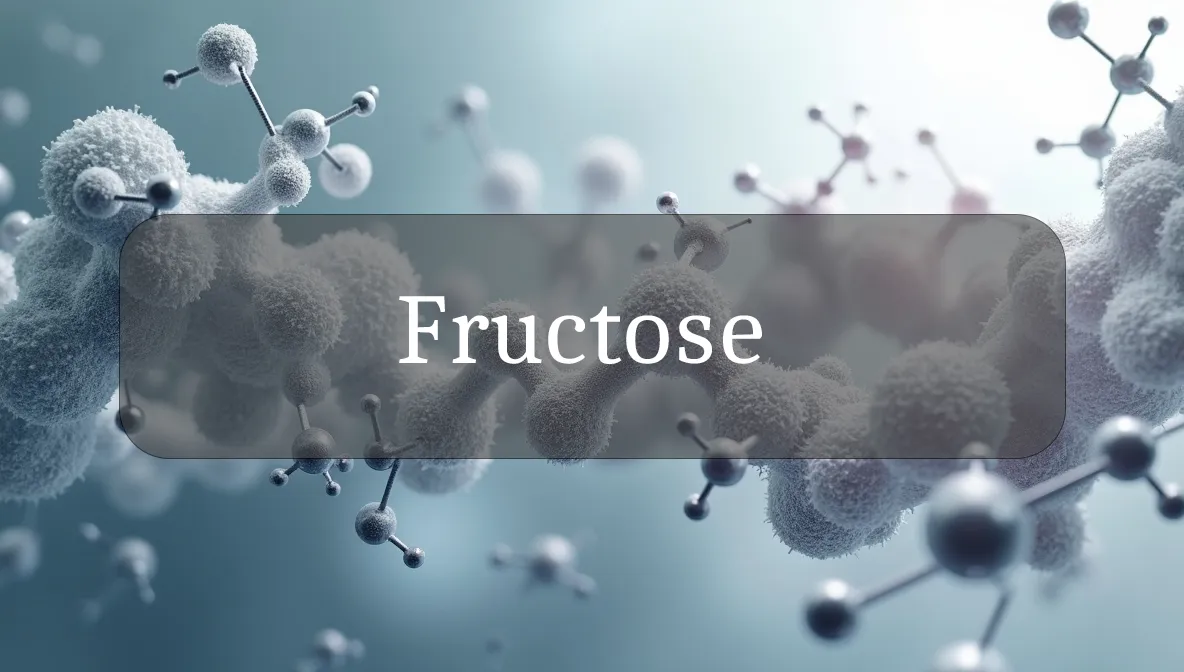Fruit Sugar for Energy and Health
Fructose is a natural sugar found in fruits, honey, and some vegetables, providing energy and sweetness but requiring moderation to avoid health issues. This guide explains what fructose is, its role in your body, and practical ways to include it in a healthy diet, all in a clear and actionable way for daily wellness.
Chemical Identity and Type
Fructose is a monosaccharide, a simple sugar with the chemical formula C₆H₁₂O₆, also known as fruit sugar. It’s sweeter than glucose and is metabolized primarily in the liver, where it’s converted into energy or stored as glycogen. Fructose is found naturally in foods and as a component of sucrose (table sugar, which is half glucose, half fructose). Think of fructose as a sweet energy source that your body processes differently from other sugars.
Biological Role and Benefits
When consumed in moderation, fructose offers several benefits:
- Energy Source: Fructose is converted into glucose or glycogen in the liver, providing energy for cells, especially during physical activity.
- Nutrient Delivery: In whole fruits, fructose comes with fiber, vitamins (e.g., vitamin C), and antioxidants, supporting immunity and overall health.
- Taste Satisfaction: Its sweetness enhances the flavor of healthy foods, making nutrient-rich diets enjoyable and sustainable.
- Glycogen Replenishment: After exercise, fructose helps restock liver glycogen, aiding recovery.
From whole food sources, fructose is a valuable part of a balanced diet.
Dietary or Natural Sources
Fructose is found in natural and processed foods:
- Natural Sources:
- Fruits: Apples, pears, grapes, bananas, and berries (1–7g per serving).
- Vegetables: Onions, artichokes, and asparagus contain small amounts.
- Honey: High in fructose (~40%), with natural antioxidants.
- Maple syrup: Contains some fructose alongside other sugars.
- Processed Sources:
- High-fructose corn syrup (HFCS): Used in sodas, candies, and processed foods (e.g., 55% fructose in soft drinks).
- Table sugar (sucrose): Found in baked goods, desserts, and beverages (50% fructose).
- Fruit juices: Concentrated fructose without fiber, leading to rapid absorption.
- Low-Fructose Alternatives:
- Low-sugar vegetables (e.g., spinach, broccoli) or proteins (e.g., eggs, fish) have minimal fructose.
- Natural sweeteners like stevia or monk fruit can replace fructose-heavy sources.
Choose whole fruits over processed foods for fructose with fiber and nutrients.
Signs of Imbalance or Dysfunction
Excess fructose or rare metabolic issues can cause problems:
- Excess Fructose Intake:
- Liver stress: High amounts (e.g., from HFCS in sodas) can overwhelm the liver, leading to fat buildup (non-alcoholic fatty liver disease).
- Weight gain: Excess fructose may increase appetite and fat storage, contributing to obesity.
- Blood sugar issues: Linked to insulin resistance and higher diabetes risk when overconsumed.
- High triglycerides: Can raise blood fats, increasing heart disease risk.
- Fructose Malabsorption (common in some with IBS):
- Bloating, gas, or diarrhea after eating high-fructose foods (e.g., apples, HFCS).
- Abdominal pain or discomfort from undigested fructose fermenting in the gut.
- Hereditary Fructose Intolerance (rare genetic disorder):
- Severe symptoms (e.g., vomiting, liver damage) from inability to metabolize fructose due to aldolase B deficiency.
- Requires strict fructose avoidance from birth.
If you experience digestive issues, weight gain, or fatigue after high-fructose foods, consult a healthcare provider. Tests like breath tests or blood panels can diagnose malabsorption or metabolic issues.
Supporting Optimal Levels or Function
To enjoy fructose’s benefits while minimizing risks:
- Prioritize Whole Fruits: Eat 2–3 servings of fruit daily (e.g., berries, apples) for fructose with fiber, which slows absorption and supports gut health.
- Limit Added Sugars: Keep added sugars (including HFCS and sucrose) below 10% of daily calories (about 25g or 6 tsp for most adults), per WHO guidelines. Check labels on sodas, candies, and processed foods.
- Pair Wisely: Combine high-fructose foods with protein (e.g., yogurt with fruit) or fat (e.g., nuts with honey) to stabilize blood sugar and reduce liver load.
- Support Liver Health: Eat fiber-rich foods (25–35g daily from veggies, whole grains) and avoid excessive alcohol to keep your liver functioning well.
- Stay Active: Exercise helps your body use fructose efficiently, reducing fat storage and improving insulin sensitivity.
- Test Tolerance: If high-fructose foods cause bloating, try low-fructose options (e.g., strawberries over mangoes) or consult a dietitian for a low-FODMAP diet.
These habits let you harness fructose’s energy without overloading your system.
Safety, Interactions, and Precautions
Fructose is safe in moderation but requires care for certain groups:
- Safety: Fructose from whole foods is well-tolerated. Overconsumption of added fructose (e.g., HFCS) can lead to metabolic issues like fatty liver or diabetes risk.
- Interactions:
- High-fructose diets may affect diabetes medications, requiring blood sugar monitoring. Consult a doctor if diabetic.
- Gut conditions (e.g., IBS) or infections can worsen fructose absorption, causing bloating. Rebuild gut health with probiotics if needed.
- Precautions:
- If you have IBS or suspect fructose malabsorption, limit high-fructose foods and seek medical advice for testing (e.g., breath tests).
- People with hereditary fructose intolerance must avoid fructose entirely—consult a specialist for a tailored diet.
- Limit HFCS-heavy foods (e.g., sodas) to prevent liver stress, especially in children or those with metabolic concerns.
Fun Fact
Fructose is twice as sweet as glucose, which is why fruits like grapes taste so delicious! It’s nature’s way of making nutrient-packed foods irresistible to humans and animals alike.
Citations
- National Institutes of Health. (2024). Fructose Metabolism and Health Effects.
- Mayo Clinic. (2023). Fructose Intolerance and Dietary Management.
- Cleveland Clinic. (2024). Sugars and Liver Health.
- World Health Organization. (2022). Guideline: Sugars Intake for Adults and Children.
- USDA FoodData Central. (2025). Nutrient Database for Fructose-Containing Foods.

